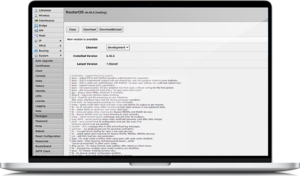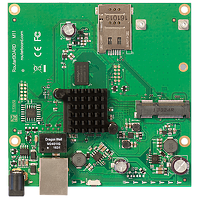Software:MikroTik RouterOS
 Interface of the RouterOS by MikroTik | |
| Developer | SIA Mikrotīkls |
|---|---|
| Kernel type | Monolithic (Linux) |
| Official website | http://https://mikrotik.com/ |
RouterOS- is a full-featured router operating system by MikroTik that runs on a PC-based hardware platform. RouterOS can convert a RouterBOARD, x86-based PC, embedded device, or a virtual machine into a dedicated router and provide a rich set of networking features. It is possible to install RouterOS on a virtual machine, VMware/ESX environment, or parallels if on Mac.[1][2]
"Main features of RouterOS:
- 802.11a/b/g/n/ac support
- Custom Nv2 TDMA protocol
- Advanced Quality of Service
- Stateful firewall, tunnels
- STP bridging with filtering
- WDS and Virtual AP
- HotSpot for Plug-and-Play access
- RIP, OSPF, BGP, MPLS routing
- Remote WinBox GUI and Web admin
- High availability with VRRP
- Bonding of Interfaces
- Telnet/mac-telnet/ssh/console admin
- Real-time configuration and monitoring
- 3G/LTE support
- OpenFlow support"
Configuration
After installing the RouterOS software or turning on the RouterBOARD for the first time, there are several ways to connect to it. They are WinBox (the GUI, graphical user interface), Webfig (via HTTP and your web browser), and a command-line via Telnet, SSH, serial cable, or even a keyboard if your Router has a VGA card.[1][2]
RouterBOARD
RouterBOARD is a hardware platform manufactured by MikroTik. In order to run RouterOS, there is no need for RouterBOARD, but MikroTik specifically designed the hardware to be a powerful router. The product can range from a tiny home router to a carrier-class access concentrator. RouterBOARD devices are either integrated, meaning in a case, ready to use, or bare motherboards ready to accept wireless interfaces and a suitable case.[1]
License
RouterBOARD devices come with a preinstalled RouterOS license. However, the user of the x86 system needs to obtain a license key. After installation, RouterOS runs in trial mode(License Level 0) for 24 hours, then the user needs to register for Level 1 or purchase Level 3,4,5,6.[1]
All license levels:
- never expire
- can use an unlimited number of interfaces
- are for one installation each
- offer unlimited software upgrades[1]
RouterOS in global projects
NASA's Aquarius project uses RouterOS within its underwater habitat and research laboratory. Aquarius is an underwater complex similar in size to the International Space Station's living quarters that rests 19 meters beneath the sea's surface. RouterOS controls the buoyant platform that provides laboratory power, life support, and communications capabilities.[4]
References
- ↑ 1.0 1.1 1.2 1.3 1.4 Discher, Stephen (2011). RouterOS by Example. p. 20-25;26-33;61-65. ISBN 978-0-615-54704-6. https://docs.google.com/viewer?a=v&pid=sites&srcid=ZGVmYXVsdGRvbWFpbnxzeWFkcm9iZXJ0b3xneDoyYjFkMzNlZTg1MWY5ZjAw.
- ↑ 2.0 2.1 Bubnov, Dmitry. "Protecting MikroTik. How to make your router safe". https://hackmag.com/security/good-mikrotik/.
- ↑ SIA Mikrotīkls. "Download MikroTik profile[PowerPoint presentation"]. https://mikrotik.com/aboutus.
- ↑ SIA Mikrotīkls (2007). "news_05". MikroTik Newsletter (5): 2. https://download2.mikrotik.com/news/news_05.pdf. Retrieved 10 April 2022.
 |


